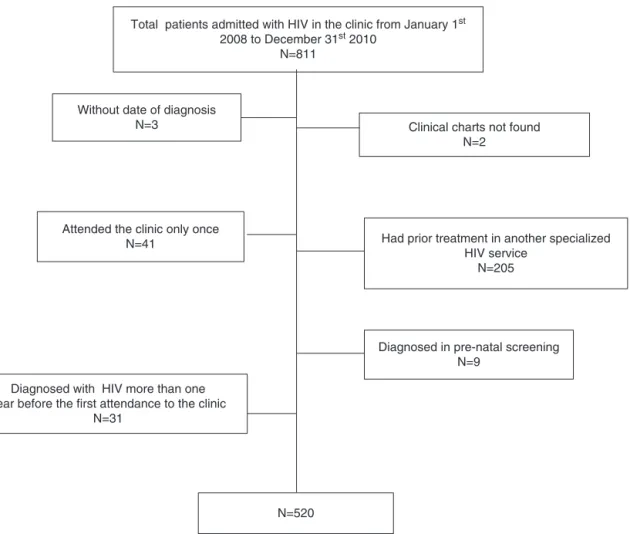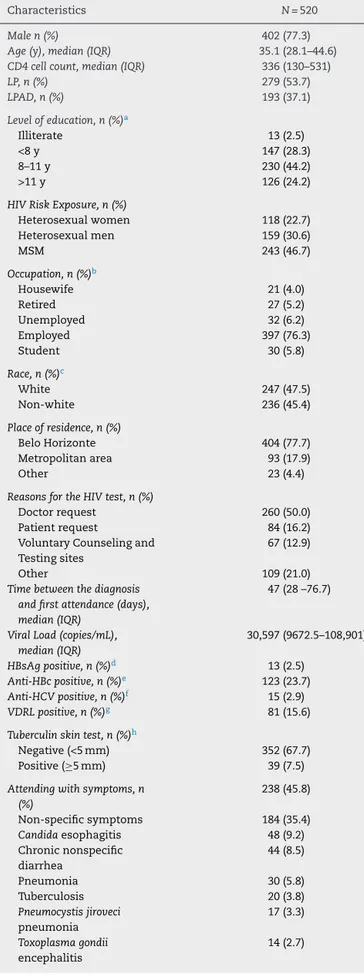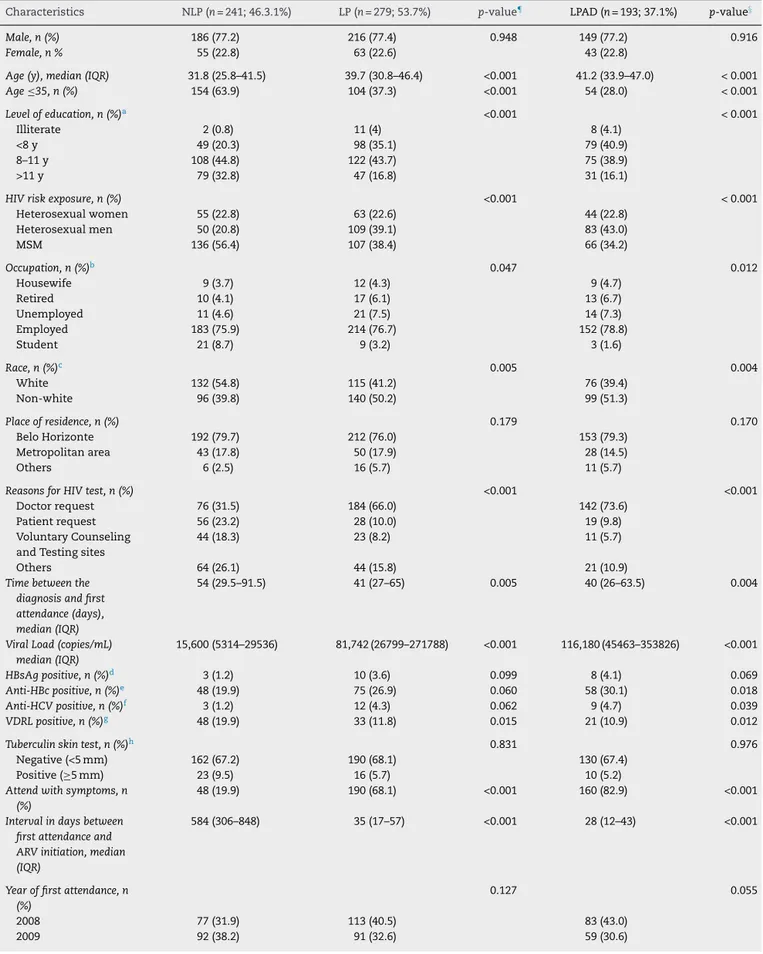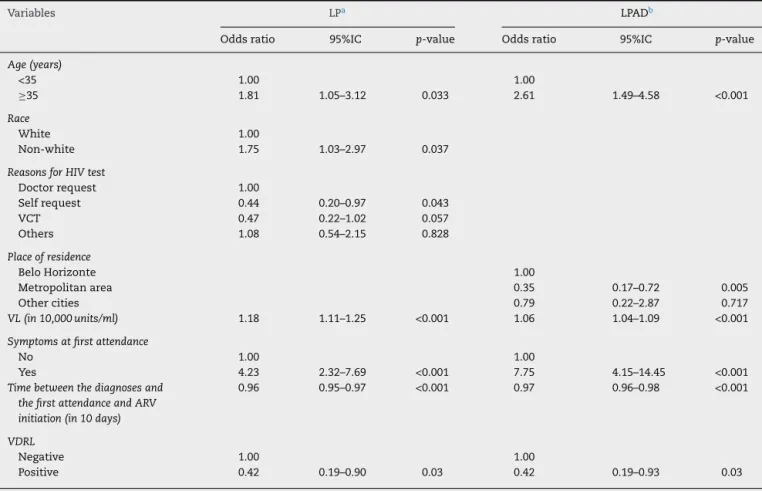ww w . e l s e v i e r . c o m / l o c a t e / b j i d
The
Brazilian
Journal
of
INFECTIOUS
DISEASES
Original
article
Evaluation
of
late
presentation
for
HIV
treatment
in
a
reference
center
in
Belo
Horizonte,
Southeastern
Brazil,
from
2008
to
2010
Melissa
Bianchetti
Valentini
a,c,∗,
Maria
Luíza
Guerra
de
Toledo
d,
Marise
Oliveira
Fonseca
a,b,
Laura
Maria
Silva
Thiersch
b,
Ingrid
Silva
Bremer
de
Toledo
b,
Flávia
Cristina
Jácome
Machado
b,
Unaí
Tupinambás
a,baPostgraduateProgramonHealthScience,InfectiousDiseasesandTropicalMedicine,UniversidadeFederaldeMinasGerais(UFMG),
BeloHorizonte,MG,Brazil
bMedicalSchool,UniversidadeFederaldeMinasGerais(UFMG),BeloHorizonte,MG,Brazil
cVoluntaryCounselingandTestingSite/SpecializedCenterinHIVOutclinicPatientsCare(CTA–SAE),BeloHorizonte,MG,Brazil dNationalSchoolofStatisticalScience–InstitutoBrasileirodeGeografiaeEstatística(IBGE),RiodeJaneiro,RJ,Brazil
a
r
t
i
c
l
e
i
n
f
o
Articlehistory:
Received7November2014
Accepted30January2015
Availableonline10March2015
Keywords:
AIDS
Latepresentation
HIVinfection
CD4cellcount
a
b
s
t
r
a
c
t
Introduction:Since1996Brazilhasprovideduniversalaccesstofreeantiretroviraltherapy,
andasaconsequence,HIV/AIDSpatients’survivalratehasimproveddramatically.However,
accordingtoscientificreports,asignificantnumberofpatientsarestilllatepresentingfor
HIVtreatment,whichleadstoconsequencesbothfortheindividualandsociety.Clinicaland
immunologicalcharacteristicsofHIVpatientsnewlydiagnosedwereaccessedandfactors
associatedwithlatepresentationfortreatmentwereevaluated.
Methods:Across-sectionalstudywascarriedoutinanHIV/AIDSreferencecenterinBelo
Horizonte,MinasGerais,inSoutheasternBrazilfrom2008to2010.Operationally,patients
withlatepresentation(LP)fortreatmentwerethosewhosefirstCD4cellcountwasless
than350cells/mm3or presentedanAIDSdefiningopportunisticinfection.Patientswith
latepresentationwithadvanceddisease(LPAD)werethosewhosefirstCD4cellcountwas
lessthan200cells/mm3orpresentedanAIDSdefiningopportunisticinfection.LPandLPAD
associatedriskfactorswereevaluatedusinglogisticregressionmethods.
Results:Fivehundredandtwentypatientswereincludedintheanalysis.ThemedianCD4
cellcountwas336cells/mm3(IQR:130–531).Twohundredandseventy-ninepatients(53.7%)
wereclassifiedasLPand193(37.1%)asLPAD.Onaverage,75%ofthepatientspresentedwith
aviralload(VL)>10,000copies/ml.Inmultivariatelogisticregressionanalysisthefactors
associatedwithLPandLPADwereage,beingsymptomaticatfirstvisitandVL.Racewasa
factorassociatedwithLPbutnotwithLPAD.
Conclusion: TheproportionofpatientswhowerelateattendingaclinicforHIVtreatmentis
stillhigh,andeffectivestrategiestoimproveearlyHIVdetectionwithaspecialfocusonthe
vulnerablepopulationareurgentlyneeded.
©2015ElsevierEditoraLtda.Allrightsreserved.
∗ Correspondingauthor.
E-mailaddress:melissabv@hotmail.com(M.B.Valentini).
http://dx.doi.org/10.1016/j.bjid.2015.01.005
Introduction
Since the early 1980s, after the first cases of infection
by HIV were reported in Brazil, the Brazilian government
responsetotheepidemicwasforceful.Itwasbasedonearly
diagnosis,treatmentandprevention,whichweresupported
by participation from civil society and respect for human
rights.1
In1996Brazilbecamethefirstdevelopingcountrytoensure
universalaccesstofreeantiretroviraltherapy(ARV)
guaran-teedbytheFederalLaw9313.Consequently,thesurvivalrate
amongBrazilianAIDS patientshasimproveddramatically.2
Inspiteofpreventiveefforts and actionstoearlydiagnose
the infection, many patients are still late presenting for
treatment.3–10,11
Itisestimatedthattherehasbeenadecreaseinthe
propor-tionofpatientswhopresentlatefortreatmentinBrazilover
recentyears.Accordingto surveillancedatareports29% of
patientspresentedwithCD4cellcountlessthan200cell/mm3
andatleasthalfofpatientspresentedwithaCD4cellcount
lessthan350cell/mm3in2012.11
It is difficult to compare the proportion of late
diag-nosis ofHIV infection in different countries and even the
trends over the years in a given country, since there are
morethan 20 criteria for this definition.12,13,14 Thisseems
to be a worldwide problem. A recent meta-analysis of 44
studiesindevelopedcountriesshowedthattheaverageCD4
cellcountinthe firstvisit fortreatmenthasnotincreased
meaningfullyinthepast20 yearsandthe majorityof
peo-plestillpresentwithCD4cellcountlessthan350cells/mm3.
15
Latediagnosis and thus delayed treatment may impact
on the individual as well as on the society. Patients
who start ARV with low CD4 cell count present higher
morbidity and mortality and have poorer treatment
response.13
Theimpactforsocietyisthatthetreatmentforlate
diag-nosisincreasescostsforthehealthsystemintheshortand
longruns.16Inaddition,thosewhopresentfortreatmentwith
moreadvanceddiseasehavehigherprobabilityof
transmis-sionsincetheydonotknowabouttheirinfectionandcannot
adoptriskreductionprecautionsorlowertheirviralloadasa
consequenceofARVtherapy.17
Abetterunderstandingoflocaldataandthefactors
associ-atedwithpatientslatepresentingfortreatmentareimportant.
Thesecouldhelpensuringpublicsurveillanceprogramsand
toprovidetargetedintervention,focusingonindividualswho
areparticularlyatrisk.
Theobjectiveofthisstudywastodescribethesocial,
demo-graphic,clinicalandimmunologicalcharacteristicsofpatients
recentlydiagnosedwithHIVinfectioninareferencecenterfor
HIV/AIDS–VoluntaryCounselingandTestingSite/Specialized
CenterinHIVOutclinicPatientCare(CTA/SAE)–inBelo
Hori-zonte,MinasGeraisstate,Brazil,from 2008to2010,and to
determinefactorsassociatedwithpatientspresentinglatefor
HIVtreatment.
Materials
and
methods
Subjectsandsettings
AllpatientswhopresentedforthefirsttimeatCTA–SAEwith
arecentHIVdiagnosisbetweenJanuary1,2008andDecember
312010wereincluded.
BeloHorizonteisoneofthemostpopulatedmetropolitan
areasinthecountryandisthecapitalcityofMinasGerais,
a state insoutheastBrazil. TheHIV detection ratesin the
city are decreasing: in June 2013 it was 27.2cases/100,000
inhabitants.11 Between 2002, when the service was
imple-mented,and2014,about3300patientshavebeenregisteredat
CTA–SAE,ofwhich2398(72.7%)arecurrentlyusingARV.Itis
oneofthethreemainclinicsthatprovideHIVtreatmentinthe
BeloHorizontemetropolitanarea,providingcareforalmost
20%ofnewlydiagnosedHIVpatientsinthecity.
Patientswereeligibleforthestudyiftheywereover18years
old;hadhadarecentdiagnosisoftheHIVinfection(defined
asthosewhohadbeendiagnosedintheprevious12months);
had initiatedtreatmentatCTA–SAEbetween the1January
2008and31 December2010,andhad hadatleastoneCD4
cellcountoranAIDSdefiningopportunisticinfection(CDC)
registered betweenthe diagnosisandoneyearthereafter.18
ToincludeonlypatientsnewlydiagnosedwithHIVinfection,
severalcriteriawereusedtoexcludepatientswhomighthave
previouslyknownabouttheirHIVinfection,orwhohada
rou-tinescreening,asduringpregnancy.
PatientswereexcludedifregisteredatCTA–SAEformore
than oneyear afterthe firstpositive HIVtest;had no
doc-umented date for their HIV test; those tested through a
pre-natal screening; and those who had attended another
HIV/AIDSspecializedcenter.Onlypatientswithatleasttwo
visitstothecenterwereincludedinthestudy.Ethicalapproval
wasobtainedfromlocalethicalcommittees.
Studydesign
Across-sectionalstudyofahistoricalcohortwascarriedout.
All data wasretrieved from clinical chartsusing
standard-izedforms.Dataabstractedfromthechartsweredemographic
information,clinicalfeatures,laboratorydata(HIVviralload,
CD4cellcounts,serologyforsyphilis,hepatitisBandC,and
tuberculin skintestresult) and timeonARVifit had been
initiatedafterthefirstappointmentattheclinic.
Definitionsandvariablesofinterest
Latepresenters(LP)werethosepatientswhosefirstCD4cell
countwasless than 350cells/mm3 and hadanAIDS
defin-ing opportunistic infection were defined aslate presenters
(LP).SubjectswhopresentedwithaCD4cellcountlessthan
200cells/mm3orhadanAIDSdefiningopportunisticinfection
weredefinedaslatepresenterswithadvanceddisease(LPAD).
Consequently,thosepatientswhosefirstCD4cellcountwas
latepresenters(NLP).Thisdefinitionisinaccordancewitha
2011EuropeanLatePresentersConsensusDefinition.19
Thefollowingexposurevariableswereconsidered:yearof
HIVdiagnosis;ageatthetimeofHIVdiagnosis;dateofthe
firstattendancetotheclinic;gender;race;levelofeducation;
occupation;placeofresidence;bepartofaself-reportedHIV
riskgroup;HIVviralload(VL);clinicalfeatures;reasonstobe
testedforHIV; hepatitisB(HBsAgand HBcantibody)andC
serology(HCVantibody);syphilis(VDRL)andtuberculinskin
test(TST).
Patients were categorized by age of the patient at the
timeofHIVdiagnosis usingthe medianage, raceaswhite
and non-white, years ofschoolingno education (illiterate),
fewer than eight years, eight to eleven years, and more
than11years,occupationashousewife,retired,unemployed,
employed,studentandother,andplaceofresidenceasBelo
Horizonte city, Belo Horizonte metropolitan area, or other
cities.
Onlysexualexposurewasconsideredasexposurerisk
cat-egory(heterosexualmen,heterosexualwomen,andmenwho
havesexwithmen–MSM)sincetherewereonlythreepatients
(0.6%)ofinjectingdrugusers(IDU).ThedateofthefirstHIV
testwas considered as the date ofHIV diagnosis.Patients
were considered symptomatic if there were any symptom
described bythe doctor inthe clinical chart. Patients who
were symptomatic at first visit, without a defining
oppor-tunisticinfection,pneumoniaorchronicnonspecificdiarrhea,
wereclassifiedaspatientswithnon-specificsymptoms.The
reasons to be tested for HIV were categorized as: doctor
request, self request, testing in Voluntary Counseling and
Testingsites(VCT),andother.
Statisticalanalyses
Thecategoricalvariables were expressedinterms of
abso-luteandrelativefrequencies,andnumericalvariableswere
expressed as medians and interquartile ranges (IQR).
Uni-variate and multivariate analysesfor factors associatedto
LP and LPADwere performed. In univariate analysis,
cate-gorical datawas comparedusing contingencytablesand a
Chi-Squaretest;numericalvariableswerecomparedusingthe
Mann–Whitney Utest. Multivariateanalysiswasconducted
usinglogisticregressionmodelswithbackwardmanual
elim-inationofvariables.
Candidatevariables formultivariateanalysiswere those
that showed an association with LP and LPAD with a
p-value≤0.20intheunivariateanalysis.Toestimatethe
mag-nitude of the association between response variables and
LP/LPAD,oddsratio(OR)with95%confidenceintervals(95%CI)
wasused.Allp-valueslessthan0.05wereconsidered
statisti-callysignificant.Goodnessoffittestingoflogisticregression
was assessed byHosmer–Lemeshow test. Statistical
analy-seswereperformedwithSPSSsoftwareversion21(SPSSInc.,
Chicago,IL,USA).
Total patients admitted with HIV in the clinic from January 1st
2008 to December 31st 2010
N=811
Had prior treatment in another specialized HIV service
N=205 Attended the clinic only once
N=41
Diagnosed with HIV more than one year before the first attendance to the clinic
N=31
Without date of diagnosis
N=3 Clinical charts not found N=2
Diagnosed in pre-natal screening N=9
N=520
Table1–CharacteristicsofnewlydiagnosedHIV patientsatinitiationoftreatmentinCTA–SAEfrom2008 to2010.
Characteristics N=520
Malen(%) 402(77.3)
Age(y),median(IQR) 35.1(28.1–44.6)
CD4cellcount,median(IQR) 336(130–531)
LP,n(%) 279(53.7)
LPAD,n(%) 193(37.1)
Levelofeducation,n(%)a
Illiterate 13(2.5)
<8y 147(28.3)
8–11y 230(44.2)
>11y 126(24.2)
HIVRiskExposure,n(%)
Heterosexualwomen 118(22.7)
Heterosexualmen 159(30.6)
MSM 243(46.7)
Occupation,n(%)b
Housewife 21(4.0)
Retired 27(5.2)
Unemployed 32(6.2)
Employed 397(76.3)
Student 30(5.8)
Race,n(%)c
White 247(47.5)
Non-white 236(45.4)
Placeofresidence,n(%)
BeloHorizonte 404(77.7)
Metropolitanarea 93(17.9)
Other 23(4.4)
ReasonsfortheHIVtest,n(%)
Doctorrequest 260(50.0)
Patientrequest 84(16.2)
VoluntaryCounselingand Testingsites
67(12.9)
Other 109(21.0)
Timebetweenthediagnosis andfirstattendance(days), median(IQR)
47(28–76.7)
ViralLoad(copies/mL), median(IQR)
30,597(9672.5–108,901)
HBsAgpositive,n(%)d 13(2.5)
Anti-HBcpositive,n(%)e 123(23.7)
Anti-HCVpositive,n(%)f 15(2.9)
VDRLpositive,n(%)g 81(15.6)
Tuberculinskintest,n(%)h
Negative(<5mm) 352(67.7)
Positive(≥5mm) 39(7.5)
Attendingwithsymptoms,n (%)
238(45.8)
Non-specificsymptoms 184(35.4)
Candidaesophagitis 48(9.2) Chronicnonspecific
diarrhea
44(8.5)
Pneumonia 30(5.8)
Tuberculosis 20(3.8)
Pneumocystisjiroveci pneumonia
17(3.3)
Toxoplasmagondii encephalitis
14(2.7)
Table1–(Continued)
Characteristics N=520
Intervalindaysbetweenfirst attendanceandARV initiation,median(IQR)
57.5(27.8–430)
Yearoffirstattendance,n(%)
2008 190(36.5)
2009 183(35.2)
2010 147(28.3)
Abbreviation:IQR,interquartilerange;LA,latepresentationtocare. a Missingdata:n=4(0.8%).
b Missingdata:n=13(2.5%).
c Missingdata:n=37(7.1%).
d Missingdata:n=19(3.7%).
e Missingdata:n=65(12.5%).
f Missingdata:n=16(3.1%).
g Missingdata:n=11(2.1%).
h Missingdata:n=129(24.8%).
Results
Atotalof811HIVinfectedpatientswereadmittedtotheclinic
betweenJanuary12008andDecember312010.Five-hundred
andtwentypatientswereeligiblefortheanalysis(Fig.1).
Themajorityofpatientsincludedweremen(77.3%)with
amedianageof35.1years(IQR28.1–44.6).Theoverallmedian
CD4cellcountwas336cells/mm3(IQR:130–531).Itwasgreater
amongMSM(390cells/mm3IQR:209–563)thanin
heterosex-ual women (338cells/mm3 IQR: 130–531) and heterosexual
men(225cell/mm3IQR:58–444).Almost70%ofthepatients
had had at least eight years of education (n=356–68.4%).
At least 75% of them lived in Belo Horizonte city.
Three-hundredandninetysevenpatients(76.3%)wereemployed.
Two-hundredandforty-threepatients(46.7%)self-reportedas
MSMand159(30.6%)self-reportedasheterosexual.From483
patientswhoprovidedinformationabouttheirracialstatus,
51%declaredthemselvesaswhiteand49%asnon-white.CD4
cellcountwasavailablefor519patients(99.8%).Thosewhodid
nothaveaCD4countmeasurement,presentedwithanAIDS
defining opportunist infection.Viral load measurementsat
firstvisitwereavailablefor97%ofthepatients.ThemedianVL
forthewholecohortwas30,597copies/ml(IQR:9673–108,901).
HBsAg,anti-HbCandanti-HCVwerepositivein13(2.5%),123
(23.7%)and15(2.9%)patients,respectively.
Two-hundredandseventy-ninepatients(53.7%)were
clas-sifiedasLPand193(37.1%)classifiedasLPAD.Despitehavinga
CD4thresholdshigherthan350cell/mm3and200cells/mm3,
eight and twenty patients met the LP and LPAD criteria,
respectively,duetothediagnosisofanAIDSdefining
oppor-tunisticinfection.Thecharacteristicsofthecohortareshown
inTable1.
Table2showsthecharacteristicsofthe patients
accord-ing totheir baseline CD4cell countmeasurement. LP and
LPADpatientsweresignificantlyolderthanNLPpatients,had
amedianageof39.7(IQR:30.8–46.4),41.2(IQR:33.9–47)and
31.8(IQR:25.8–41.5),respectively(p<0.001).Theproportionof
MSMamongLPandLPADwas38.4%and34.2%,respectively,
Table2–ComparisonofnewHIVpatientsatinitiationoftreatmentinCTA–SAEfrom2008–2010accordingtotheir baselineCD4cellcount.
Characteristics NLP(n=241;46.3.1%) LP(n=279;53.7%) p-value¶ LPAD(n=193;37.1%) p-value§
Male,n(%) 186(77.2) 216(77.4) 0.948 149(77.2) 0.916
Female,n% 55(22.8) 63(22.6) 43(22.8)
Age(y),median(IQR) 31.8(25.8–41.5) 39.7(30.8–46.4) <0.001 41.2(33.9–47.0) <0.001
Age≤35,n(%) 154(63.9) 104(37.3) <0.001 54(28.0) <0.001
Levelofeducation,n(%)a <0.001 <0.001
Illiterate 2(0.8) 11(4) 8(4.1)
<8y 49(20.3) 98(35.1) 79(40.9)
8–11y 108(44.8) 122(43.7) 75(38.9)
>11y 79(32.8) 47(16.8) 31(16.1)
HIVriskexposure,n(%) <0.001 <0.001
Heterosexualwomen 55(22.8) 63(22.6) 44(22.8)
Heterosexualmen 50(20.8) 109(39.1) 83(43.0)
MSM 136(56.4) 107(38.4) 66(34.2)
Occupation,n(%)b 0.047 0.012
Housewife 9(3.7) 12(4.3) 9(4.7)
Retired 10(4.1) 17(6.1) 13(6.7)
Unemployed 11(4.6) 21(7.5) 14(7.3)
Employed 183(75.9) 214(76.7) 152(78.8)
Student 21(8.7) 9(3.2) 3(1.6)
Race,n(%)c 0.005 0.004
White 132(54.8) 115(41.2) 76(39.4)
Non-white 96(39.8) 140(50.2) 99(51.3)
Placeofresidence,n(%) 0.179 0.170
BeloHorizonte 192(79.7) 212(76.0) 153(79.3)
Metropolitanarea 43(17.8) 50(17.9) 28(14.5)
Others 6(2.5) 16(5.7) 11(5.7)
ReasonsforHIVtest,n(%) <0.001 <0.001
Doctorrequest 76(31.5) 184(66.0) 142(73.6)
Patientrequest 56(23.2) 28(10.0) 19(9.8)
VoluntaryCounseling andTestingsites
44(18.3) 23(8.2) 11(5.7)
Others 64(26.1) 44(15.8) 21(10.9)
Timebetweenthe diagnosisandfirst attendance(days), median(IQR)
54(29.5–91.5) 41(27–65) 0.005 40(26–63.5) 0.004
ViralLoad(copies/mL) median(IQR)
15,600(5314–29536) 81,742(26799–271788) <0.001 116,180(45463–353826) <0.001
HBsAgpositive,n(%)d 3(1.2) 10(3.6) 0.099 8(4.1) 0.069
Anti-HBcpositive,n(%)e 48(19.9) 75(26.9) 0.060 58(30.1) 0.018
Anti-HCVpositive,n(%)f 3(1.2) 12(4.3) 0.062 9(4.7) 0.039
VDRLpositive,n(%)g 48(19.9) 33(11.8) 0.015 21(10.9) 0.012
Tuberculinskintest,n(%)h 0.831 0.976
Negative(<5mm) 162(67.2) 190(68.1) 130(67.4)
Positive(≥5mm) 23(9.5) 16(5.7) 10(5.2)
Attendwithsymptoms,n (%)
48(19.9) 190(68.1) <0.001 160(82.9) <0.001
Intervalindaysbetween firstattendanceand ARVinitiation,median (IQR)
584(306–848) 35(17–57) <0.001 28(12–43) <0.001
Yearoffirstattendance,n (%)
0.127 0.055
2008 77(31.9) 113(40.5) 83(43.0)
Table2–(Continued)
Characteristics NLP(n=241;46.3.1%) LP(n=279;53.7%) p-value¶ LPAD(n=193;37.1%) p-value§
2010 72(29.9) 75(26.9) 51(26.4)
Abbreviations:NLP,notlatepresentation;LP,latepresentationtocare;LPADlatepresentationwithadvanceddisease;IQR,interquartilerange; MSM,menwhohavesexwithmen;VCT,VoluntaryCounselingandTestingsites.
a Missingdata:n=3(1.2%)–NLP;n=1(0.4%)–LP;n=0–LPAD. b Missingdata:n=7(2.9%)–NLP;n=6(2.2%)–LP;N=2(1.0%)–LPAD. c Missingdata:n=13(5.4%)–NLP;n=24(8.6%)–LA;N=18(9.3%)–LPAD. dMissingdata:n=11(4.6%)–NLP;n=8(2.9)–LP;N=4(2.1)–LPAD. e Missingdata:n=24(9.9%)–NLP;n=41(14.7)–LP;N=29(15.0)–LPAD. f Missingdata:n=10(4.1%)–NLP;n=6(2.2)–LP;N=5(2.6)–LPAD. g Missingdata:n=7(2.9%)–NLP;n=4(1.4)–LP;N=4(2.1)–LPAD. h Missingdata:n=56(23.2%)–NLP;n=73(26.2)–LP;N=53(27.5)–LPAD.
¶p-valuecomparingNLPtoLP.
§ p-valuecomparingNLPtoLPAD.
ofNLPwereMSM.Ontheotherhand,theproportionof
hetero-sexualmenwashigheramongLPandLPAD.Theproportion
ofpatientswithmorethan11yearsofschoolingintheNLP
groupwastwicetheproportionamongLPandLPADgroups.
Half of the patients in the cohort were tested for HIV
becauseadoctoradvisedthemtodosoandthisproportion
increasedinLP(66.0%)andLPAD(73.6%)groupsanddecreased
amongNLP(31.5%).
ThemedianVLwasalmostsixandeightfoldhigheramong
LPandLPAD,respectively,whencomparedtoNLP.Co-infection
withhepatitisBwashigherinLPandLPADgroupsthanamong
NLPbutwithoutstatisticalsignificance(p=0.099forLPand
p=0.069forLPAD).TheproportionofpositiveHCV-antibody
washigherinLPandLPADgroupsbutwithoutstatistical
sig-nificanceforLP(p=0.06).
Themediantimebetweenthediagnosisandthefirstvisit
tothetreatmentcenterwasshorterinLPandLPADgroups
thanamongNLP.Theproportionofsymptomaticpatientsat
firstvisitwashigherinLP(68.1%)andLPAD(82.9%)groups
thaninNLP(19.9%)group.ThemostreportedAIDSdefining
opportunisticinfectionsinLPandLPADgroupswereCandida
esophagitis (n=48), Pneumocystis jiroveci pneumonia(n=17),
Toxoplasmagondiiencephalitis(n=14)andtuberculosis(n=20).
Non-AIDS defining conditionsincluded chronic nonspecific
diarrhea(n=44),bacterialpneumonia(n=24)andnonspecific
symptoms(n=142).InNLPgroup48patientsreported
symp-tomsatfirstvisit;sixhadhadabacterialpneumoniaand42
nonspecificsymptoms.
The results of univariate analysis using binary logistic
regressiontoidentifyfactorsassociatedtoLPandLPADare
showninTable3.Ageover35yearscomparedtothoseunder
35;non-white compared to white;heterosexual men
com-paredtoHSH;high VLand beingsymptomaticatfirstvisit
comparedtonon-symptomatic patientswereall associated
withLPorLPAD.
Beingretired,unemployed,oremployedwereallassociated
withLPandLPADwhencomparedtostudents.Beinga
house-wifewasassociatedtoLPADbutnotwithLP.Protectivefactors
werehavingcompleted morethan eightyearsofschooling
comparedtolessthaneightyears,nothavingdonetheHIVtest
becauseadoctorhadrequestedandhavingapositiveVDRL.
Startingcarein2009comparedtostartingcarein2008was
associatedwithlesschancetobeLPAD.
The factors associatedwith LPin the final multivariate
logisticregressionmodelwereage,race,reasonstobetested
forHIV,VL,symptomsatfirstvisit,timebetweenHIVdiagnosis
andthefirstvisit,andVDRL(Table4).Similarly,the
predic-tivefactorsforLPADwerethesameasforLPexceptraceand
reasontobetestedforHIV.FactorsassociatedwithlessLP
wereselfrequestforbeingtestedforHIVcomparedto
doc-tor’srequest,andhavingapositiveVDRL.Factorsassociated
withlessLPADwerelivinginthemetropolitanareacompared
tolivinginBeloHorizonte,andhavingapositiveVDRL.ForA
shorterintervalbetweenthefirstvisitandARVinitiationwere
associatedwithbothLPandLPAD.
Discussion
TheproportionofLP(53.7%)andLPAD(37.1%)foundinthis
studywassignificantlyelevated.Theseratesarehigh,
espe-ciallyinBrazil,whereawellrecognizedpublichealthAIDS
programisavailableforover30years.
These findings were higher than those reported by the
BrazilianHealthMinistryinrecentyears.11 Similartoother
studiesinBeloHorizontecity,70%oftheLPstartedcarewith
CD4cell countless than200cells/mm3.4,9 TheLPADinthis
study was less frequentthan reported previously in other
Brazilianstudieswhichrangedfrom40.8%to61%.3,6
Compared to surveillance data for the whole HIV/AIDS
Brazilianpopulation,therewasahigherproportionofmale
subjectsaswellasMSMinthiscohort.Patientsincludedin
this cohorthad highereducationallevels thanreportedfor
theoverallBrazilianpopulation10,11andforBeloHorizontein
particular.4,9Theproportionofeachracedidnotdifferfrom
thenationaldata.
In other limited-resource regions such as in African
countries, the proportion ofLP and LPAD are higher than
that observed in this study with 70–80% presenting with
advanced disease and 50–60% with CD4 count less than
350cells/mm3.20–22InMexicoaswellasinAfricathe
propor-tionofLPADwasestimatedtobe61%.23TheproportionofLP
wassimilartodatafrom35countriesinEurope,24theUnited
StatesofAmerica(USA)andCanada.25
LP and LPAD patients were older and this is in
accor-dancewiththeliterature.3,6,13,24–26Thispopulationmighthave
Table3–UnivariateanalysisoffactorsassociatedwithLPandLPADofnewHIVpatientswhoinitiatetreatmentin CTA–SAE2008–2010.
Variables LP LPAD
Oddsratio 95%IC p-value Oddsratio 95%IC p-value
Sex
Male 1.00 1.00
Female 0.99 0.65–1.49 0.948 1.01 0.66–1.54 0.965
Age(years)
<35 1.00 1.00
≥35 2.98 2.08–4.26 <0.001 4.27 2.90–6.28 <0.001
HIVriskexposure
Heterosexualwomen 1.46 0.94–2.26 0.095 1.59 1.00–2.55 0.051
Heterosexualmen 2.77 1.82–4.22 <0.001 2.93 1.92–4.46 0.000
MSM 1.00 1.00
Levelofeducation(years)
Illiterate 2.75 0.59–12.89 0.415 1.38 0.43–4.41 0.590
<8 1.00 1.00
8–11 0.56 0.37–0.87 0.009 0.42 0.27–0.64 <0.001
>11 0.30 0.18–0.49 <0.001 0.28 0.17–0.47 <0.001
Occupation
Housewife 3.11 0.97–9.97 0.056 6.75 1.55–29.45 0.011
Retired 3.97 1.31–11.97 0.014 8.36 2.04–34.29 0.003
Unemployed 4.45 1.53–12.97 0.006 7.00 1.76–27.89 0.006
Employed 2.73 1.22–6.11 0.015 5.58 1.67–18.72 0.005
Students 1.00 1.00
Race
White 1.00
Non-white 1.67 1.17–2.40 0.005 1.63 1.12–2.36 0.011
Placeofresidence
BeloHorizonte 1.00
Metropolitanarea 1.05 0.67–1.65 0.823 0.71 0.42–1.15 0.162
Othercities 2.42 0.93–6.30 0.071 1.64 0.69–3.88 0.259
ReasonfortheHIVtest
Doctorrequirement 1.00 1.00
Patientrequirement 0.21 0.12–0.35 <0.001 0.24 0.14–0.43 <0.001
VCT 0.22 0.12–0.38 <0.001 0.16 0.08–0.33 <0.001
Other 0.28 0.18–0.45 <0.001 0.20 0.12–0.34 <0.001
Timebetweenthediagnosis andthefirstattendance(in 10days)
0.97 0.94–1.00 0.040 0.97 0.94–1.01 0.117
VL(in10,000units/ml) 1.21 1.15–1.27 <0.001 1.10 1.07–1.12 <0.001
Symptomsatfirstattendance
No 1.00
Yes 8.53 5.73–12.86 <0.001 15.48 9.84–24.34 <0.001
Timebetweenthediagnosis andthefirstattendanceand ARVinitiation(in10days)
0.96 0.95–0.97 <0.001 0.96 0.95–0.97 <0.001
Yearoffirstattendance
2008 1.00
2009 0.68 0.46–1.02 0.061 0.62 0.41–0.93 0.021
2010 0.70 0.45–1.10 0.122 0.69 0.44–1.09 0.112
VDRL
Negative 1.00 1.00
Positive 0.53 0.33–0.86 0.010 0.54 0.32–0.92 0.024
HbsAg
Negative 1.00 1.00
Table3–(Continued)
Variables LP LPAD
Oddsratio 95%IC p-value Oddsratio 95%IC p-value
Anti-HCV
Negative 1.00 1.00
Positive 3.49 0.97–12.54 0.055 2.62 0.92–7.48 0.072
Abbreviations:LP,latepresentationtocare;LPAD,latepresentationwithadvanceddisease;IQR,interquartilerange;MSM,menwhohavesex withmen;VCT,VoluntaryCounselingandTestingsites;VL,viralload;ARV,antiretroviraltherapy;IC,intervalofconfidence.
generations.Beingover35yearswasassociatedwithLP(OR: 1.81 95%IC 1.05–3.12, p=0. 033) and LPAD (OR: 2.61 95%IC 1.49–4.58,p=0.001).
TheproportionofpositiveTSTinthe entirecohortwas
7.5%.AlthoughtheproportionofpositiveTSTwashigherin theNLPgroupthaninLPandLPADgroupstherewereno statis-ticaldifference(p=0.831andp=0.976,respectively).Thiscould beexplainedbythehighproportionofmissingTSTresults (24.8%).
AsshownintheBraziliansurveillancedata,sexual trans-missionisthemainrouteoftransmissionastheIDUgroup wasminimal.11
Gender was not associated with LP and LPAD.
How-ever,amongpatientsself-reportedasheterosexual, women
presentedearlierthanmen.Sixty-eightpercentof
heterosex-ual menwere LPversus 53% ofheterosexual women.This
couldbeexplainedbythefactthatBrazilianwomentake
bet-tercareoftheirhealththanmen,andseekhealthservicesfor
preventiveexamsmorefrequently.27Heterosexualexposure,
particularlyamongmales,iswidelycorrelatedwithlate
pre-sentationandthiscouldbeexplainedbyfeweropportunities
tobetested, astheyare notthemaintargetofcampaigns
launched bythe governmentas wellas theirown lowrisk
perception.12,13
Compared to students, being retired, unemployed or
employedwasassociatedwithLPandLPADinunivariate
anal-ysis.BeingahousewifewasassociatedtoLPADbutnotwith
LP. These associations didhold inmultivariate analysis. A
Table4–FinalModelofMultivariateRegressionoffactorsassociateswithLPanLPADofnewHIVpatientswhoinitiate treatmentinCTA–SAE2008–2010.
Variables LPa LPADb
Oddsratio 95%IC p-value Oddsratio 95%IC p-value
Age(years)
<35 1.00 1.00
≥35 1.81 1.05–3.12 0.033 2.61 1.49–4.58 <0.001
Race
White 1.00
Non-white 1.75 1.03–2.97 0.037
ReasonsforHIVtest
Doctorrequest 1.00
Selfrequest 0.44 0.20–0.97 0.043
VCT 0.47 0.22–1.02 0.057
Others 1.08 0.54–2.15 0.828
Placeofresidence
BeloHorizonte 1.00
Metropolitanarea 0.35 0.17–0.72 0.005
Othercities 0.79 0.22–2.87 0.717
VL(in10,000units/ml) 1.18 1.11–1.25 <0.001 1.06 1.04–1.09 <0.001
Symptomsatfirstattendance
No 1.00 1.00
Yes 4.23 2.32–7.69 <0.001 7.75 4.15–14.45 <0.001
Timebetweenthediagnosesand thefirstattendanceandARV initiation(in10days)
0.96 0.95–0.97 <0.001 0.97 0.96–0.98 <0.001
VDRL
Negative 1.00 1.00
Positive 0.42 0.19–0.90 0.03 0.42 0.19–0.93 0.03
Abbreviations:VCT,VoluntaryCounselingandTestingsites;VL,viralload;ARV,antiretroviraltherapy;IC,intervalofconfidence.
possibleexplanationisthelowermedianageofthestudents
(23yearsIQR:22–29)ascomparedtothemedianageofthe
othergroups.Furthermore,theproportionofMSMamongthe
studentswereexpressive(83.3%).
MSM presented earlier to care than heterosexual men,
accordingtounivariatebutnotmultivariateanalyses,possibly
becauseonaverageheterosexualpatientswereolderthanthe
MSMgroup.Themedianageofheterosexualwomenwas42
years(IQR:33–49),39(IQR:33–47)forheterosexualmen,and
30(IQR:25–38)forMSM(p<0.001).EventhoughMSMmakeup
halftheHIVinfectedpopulation,theyareinfectedatalower
age,perceivethemselvesatriskandgettestedatanearlier
stage,HIVpreventionforthisgroupremainsachallenge.
In this study, the rates of HBsAg, anti-HBc and
anti-HCVpositive were lower than thosereported forHIV/AIDS
patientsin Africa.20 However,theserates are four, sixand
twofoldgreaterthantheratesreportedforthegeneral
Brazil-ianpopulation.28ThefactthatthehepatitisBvirushasthe
same infection routes as HIV could explainthis increased
proportion.Therefore,itisimportanttoreinforcehepatitisB
vaccinationinthepopulation.
Non-whiteswasshownbeathigherriskforLPin
multi-variateanalysis.However,itshouldbepointedoutthatthe
meaneducationallevelofnon-whiteswaslowerthaninthe
white group. The proportionof non-whites with less than
eightyearsofeducationwas60.2%versus24%inthewhite
group(p<0.001).Thisfactispossiblyrelatedtodisparitiesin
accesstohealthcare,socialeconomicconditionsandaccess
toeducation.
LivingintheBeloHorizontemetropolitanareawasafactor
thatreducedLPADinmultivariateanalysispossiblybecause
60%ofthispopulationhadtheirHIVtestdoneforother
rea-sons including blood donation. To be accepted, donors be
healthysincetheyarescreenedbyadoctorbeforethe
dona-tiontakesplace.
Itisdifficulttocomparetheintervalbetweendiagnosisand
treatment,sinceinmanystudies,thefirstCD4cell
measure-mentisconsideredasthestartofcare.Inthisstudyamedian
intervalof47days(IQR:28–77)wasfoundfortheoverall
popu-lation,whichwasloweramongLP(41days)andLPAD(40days)
thaninNLPgroup(54days)andcorrelateswiththeseverityof
thediseaseandtheneedtostartARVtreatmentimmediately.
Theproportion of patients who presentedwith clinical
symptomswashighanditwasassociatedwithincreasedrisk
ofLPandLPADinmultivariateregression.Itisimportantto
stressthat32% ofLPand 18%ofLPADwere asymptomatic
atpresentation inspite ofhaving a high level ofimmune
depletion.Therefore,itisimportanttoreinforceCD4cell
mea-surementafterdiagnosis,whetherthepatientissymptomatic
ornot.Furthermore,ahighproportionofpatientshadtheir
HIVtestdonebecauseofadoctor’sreferralinLPandLPAD
groups.Thismustbeanalyzedwithcautionandcould
repre-sentalowperceptionofriskandalowknowledgeoftheHIV
disease.
SimilarresultswerefoundinastudyfromRiodeJaneiro
andBaltimore,5where75%ofthestudiedpopulationstarted
treatmentwithVL>10.000copies/ml,whichindicatesahigh
potentialforHIVtransmission.AstheimpactofARVandthe
decreaseinVLareconvincinglydemonstratedanditsimpact
intransmissioniswidelyaccepted29theresultsofthisstudy
showthehighriskoftransmissionbythosesubjectsbefore
theyarediagnosed.Inthisway,enthusiasmforHIVtreatment
asapreventionmeasuretoreducetransmissionisunlikelyto
beaccomplishedunlessearlydiagnosisisimproved.
Thesefindingsarealsorelevantinclinicalsettings.Many
guidelines30,31 haverecommended ARVinitiation athigher
CD4cellcounts,butthisdiscussionisnotapplicableforthe
majorityofnewHIVpatientssincetheypresentfortreatment
withCD4thresholdsbelowtherecommendednumber.
A positive VDRL was associated with a lower chance
of presenting late fortreatment. In fact a person with an
activesymptomaticsexuallytransmitteddisease(STD)might
request ahealthservice whereearly HIVtestingisoffered.
Itisnoteworthythat65%ofthepatientswithpositiveVDRL
wereinthegroupofMSM,whichreinforcestheimportance
ofpreventioninthisgroup.InthisstudyonlypositiveVDRL
was considered and syphilis was not classified in clinical
stages.
AlthoughalowerriskofLPwasnotedin2009inunivariate
analysis,thisdidnotholdtrueinthemultivariateanalysis.In
fact,anincreaseinthemedianlevelsofCD4cellswasfound
in2009(377cell/mm3–IQR:151–572)and2010(371cells/mm3
–IQR:164–530)comparedto2008(272cell/mm3–IQR:91–489).
Nevertheless, theproportionofheterosexualmalesin2008
washigher(36.8%)thanin2009(29%)and2010(24.5%)andthis
couldbeconsideredasaconfoundingfactor.Thisdifference
intheproportionofheterosexualmenintheseyearscouldnot
beexplainedbythestudy.
Thisstudy has limitations.Asahistorical study from a
singleHIV cohort, theymay notberepresentative ofother
national or international sites, though our analysis may
provideinsightsapplicabletosuchsettings.Medicalrecords
withcompleteinformationwereanimportantpointofthis
study.Thequalityofdatacollectedhasledtoaveryfew
miss-ingvalues.
Insummarytheresultsshowthatdespitetheavailability
ofARVfreeofchargeinBrazilformorethan15yearsand
mas-sivemediacampaignsencouragingHIVtestinginthecountry,
theproportionofpatientsstartingtreatmentlateisstillhigh.
Theseresultssuggestthatrecommendationforearlier
treat-ment will havelittle impact in preventionunless effective
strategiestoincreaseuniversalHIVtestingareimplemented.
Specialfocusshouldbeplacedonthosewhoarenotperceived
tobeordonotperceivethemselvestobeatriskforHIV
infec-tion,suchaselderlypeople,non-whites,lesseducatedpeople,
andheterosexualmen.
Conflicts
of
interest
Theauthorsdeclarenoconflictsofinterest.
r
e
f
e
r
e
n
c
e
s
1.LeviGC,VitóriaMAA.FightingagainstAIDS:theBrazilian experience.AIDS.2002;16:2373–83.
3. Souza-JrPRB,SzwarcwaldCL,CastilhoEA.Delayin
introducingantiretroviraltherapyinpatientsinfectedbyHIV inBrazil,2003–2006.Clinics.2007;62:579–84.
4. FernandesJRM,AcúrcioFA,CamposLN,GuimarãesMDC.
InitiationofantiretroviraltherapyinHIV-infectedpatients withsevereimmunodeficiencyinBeloHorizonte,Minas GeraisState,Brazil.CadSaudePublica.2009;25:1369–80.
5. MoreiraRI,LuzPM,StruchinerCJ,etal.Immunestatusat presentationforHIVclinicalcareinRiodeJaneiroand Baltimore.JAcquirImmuneDeficSyndr.2011;57Suppl. 3:S171–8.
6. PereiraGS,deSouzaMS,CaetanoKA,etal.LateHIVdiagnosis andsurvivalwithin1yearfollowingthefirstpositiveHIVtest inalimited-resourceregion.JAssocNursesAIDSCare. 2011;22:313–9.
7. OliveiraMT,LatorreMR,GrecoDB.Theimpactoflate diagnosisonthesurvivalofpatientsfollowingtheirfirst AIDS-relatedhospitalizationinBeloHorizonte,Brazil.AIDS Care.2012;24:635–41.
8. SchechterM,PachecoAG.LatediagnosisofHIVinfectionin Brazildespiteover15yearsoffreeanduniversalaccessto treatment.AIDSResHumRetroviruses.2012;28:1541–2.
9. RibeiroFA,TupinambásU,FonsecaMO,GrecoDB.Durability ofthefirstcombinedantiretroviralregimeninpatientswith AIDSatareferencecenterinBeloHorizonteBrazil,from1996 to2005.BrazJInfectDis.2012;16:27–33.
10.FonsecaMO,TupinambásU,SouzaAIA,BaisleyK,GrecoDB, RodriguesL.ProfileofpatientsdiagnosedwithAIDSatage60 andaboveinBrazil:from1980untilJune2009,comparedto thosediagnosedatage18to59.BrazJInfectDis.
2012;16:552–7.
11.Brasil.MinistériodaSaúdeSecretariadeVigilânciaemSaúde.
DepartamentodeDST,AIDSeHepatitesVirais.Boletim
EpidemiológicoAIDSeDST,Brasília;2013,December
http://www.AIDS.gov.br/publicacao/2013/boletim-epidemiologico-AIDS-e-dst-2013[accessed04.01.14]. 12.AntinoriA,JohnsonM,MorenoS,YazdanpanahY,Rockstroh
JK.ReportofaEuropeanWorkingGrouponlatepresentation withHIVinfection:recommendationsandregionalvariation. AntivirTher.2010;15Suppl.1:31–5.
13.AdlerA,Mounier-JackS,CokerRJ.LatediagnosisofHIVin Europe:definitionalandpublichealthchallenges.AIDSCare. 2009;21:284–93.
14.MukoloA,VillegasR,AliyuM,WallstonKA.Predictorsoflate presentationforHIVdiagnosis:aliteraturereviewand suggestedwayforward.AIDSBehav.2013;17:5–30.
15.LeskoCR,ColeSR,ZinskA,PooleC,MugaveroMJ.A
systematicreviewandmeta-regressionoftemporaltrendsin adultCD4(+)cellcountatpresentationtoHIVcare,1992–2011. ClinInfectDis.2013;57:1027–37.
16.KrentzHB,GillJ.DespiteCD4cellcountreboundthehigher initialcostsofmedicalcareforHIV-infectedpatientspersist5 yearsafterpresentationwithCD4cellcountslessthan350l. AIDS.2010;24:2750–3.
17.MarksG,CrepazN,SenterfittJW,JanssenRS.Meta-analysisof high-risksexualbehaviorinpersonsawareandunawarethey areinfectedwithHIVintheUnitedStates:implicationsfor HIVpreventionprograms.JAcquirImmuneDeficSyndr. 2005;39:446–53.
18.CenterforDiseaseControl(U.S).1993Revisedclassification systemforHIVinfectionandexpandedsurveillancecase
definitionforAIDSamongadolescentsandadults.MMWR RecommRep.1992;41:961–2.
19.AntinoriA,CoenenT,CostagiolaD,etal.Latepresentationof HIVinfection:aconsensusdefinition.HIVMed.2011;12:61–4.
20.AgabaPA,MeloniS,SueliH,etal.Patientswhopresentlateto HIVcareandassociatedriskfactorsinNigeria.HIVMed. 2014;15:396–405.
21.ForbiJC,ForbiTD,AgwaleSM.Estimatingthetimeperiod betweeninfectionanddiagnosisbasedonCD4+countsat firstdiagnosisamongHIV-1antiretroviralnaïvepatientsin Nigeria.JInfectDevCtries.2010;4:662–7.
22.AdmouB,ElhartiE,OumzilH,etal.Clinicaland immunologicalstatusofanewlydiagnosedHIVpositive population,inMarrakech,Morocco.AfrHealthSci. 2010;10:325–31.
23.Crabtree-RamírezB,Caro-VeraY,Belaunzarán-ZamudioF, Sierra-MaderoJ.HighprevalenceoflatediagnosisofHIVin MexicoduringtheHAARTera.SaludPublicaMex.
2012;54:506–14.
24.MocroftA,LundgrenJD,SabinML,etal.Riskfactorsand outcomesforlatepresentationforHIV-positivepersonsin Europe:resultsfromthecollaborationofobservationalHIV EpidemiologicalResearchEuropeStudy(COHERE).PLoSONE. 2013;10:e1001510.
25.AlthoffKN,GangeSJ,KleinMB,etal.Latepresentationfor humanimmunodeficiencyviruscareintheUnitedStatesand Canada.ClinInfectDis.2010;50:1512–20.
26.BlancoJR,CaroAM,Pérez-CachafeiroS,etal.HIVinfection andaging.AIDSRev.2010;12:218–30.
27.BrasilMinistériodaSaúdeSecretariadeVigilânciaemSaúde.
SecretariadeGestãoEstratégicaeParticipativa.VigitelBrasil
2007,VigilânciadosFatoresdeRiscoeProtec¸ãoparaDoenc¸as
CrônicasporInquéritoTelefônico.Brasília;2012.Available
from:
http://www.sbpt.org.br/downloads/arquivos/vigitel2012.pdf.
[accessed22.05.14].
28.Brasil.MinistériodaSaúdeSecretariadeVigilânciaemSaúde.
DepartamentodeDST,AIDSeHepatitesVirais.Estudode
PrevalênciadeBasePopulacionaldasInfecc¸õespeloVírusdas
HepatitesA,BeCnascapitaisdoBrasil.Brasília;2010.
Availablefrom:http://www.AIDS.gov.br/sites/default/files/
anexos/publicacao/2010/50071/estudoprevalenciahepatites pdf26830.pdf[accessed07.04.13].
29.CohenMS,ChenYQ,McCauleyM,etal.PreventionofHIV-1 infectionwithearlyantiretroviraltherapy.NEnglJMed. 2011;365:493–505.
30.Brasil.MinistériodaSaúdeSecretariadeVigilânciaemSaúde.
DepartamentodeDST,AIDSeHepatitesVirais.Protocolo
ClínicoeDiretrizesTerapêuticasparaManejodaInfecc¸ão
peloHIVemAdultos.Brasília;2013.Availablefrom
http://www.AIDS.gov.br/publicacao/2013/protocolo-clinico-e-diretrizes-terapeuticas-para manejo-da-infeccao-pelo-hiv-em-adul[accessed02.12.13].
31.DepartmentofHealthandHumanServices(DHHS).Panelon
antiretroviralguidelinesforadultsandadolescents.
Guidelinesfortheuseofantiretroviralagentsin
HIV-1-infectedadultsandadolescents;2013,February.
Availablefrom:http://AIDSinfo.nih.gov/ContentFiles/




